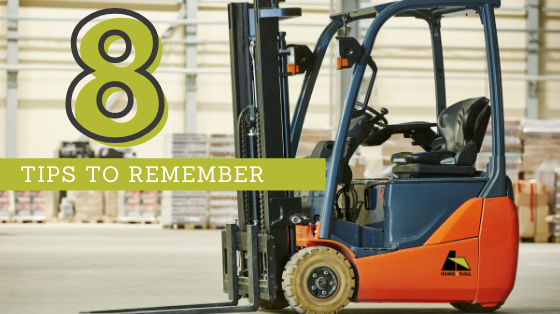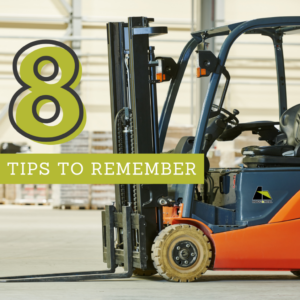
National Forklift Safety Day: 8 Tips to Remember
Forklifts are a warehouse’s best friend, but using them comes with risks. Learn how to protect your team with these 8 easy forklift safety tips.

1. Load Distribution
Proper weight distribution is an essential aspect for safe forklift operation. Always check your manual for maximum load capacity. Overloading a forklift can result in tipping, steering malfunctions, or the load falling off the forks.
Incorrectly loading a forklift can also cause problems. Always balance the load and stop if you notice the forklift straining or tipping.
2. Proper Preparation
Forklift operators should be in full PPE, including safety equipment, high-visibility jacket, safety shoes, and hard hat, as required by environmental factors and company policies. Operators should avoid loose clothing. It can get caught on the truck and interfere with the controls. Operators need to have dry shoes and hands.
A forklift should never be operated unless the driver is seated in the designated operator’s seat and all body parts are within the truck. They should always fasten the seatbelt throughout the operation and ensure all controls and mirrors are adjusted.
Always switch off your forklift when recharging or refueling it. Only refuel in well-ventilated, flame-free areas.
3. Visibility
Your operators should maintain clear visibility by carrying loads closer to the floor. If an operator’s visibility is obstructed, they may need a second employee to assist, or must otherwise confirm it’s safe to proceed. This is especially important when positioning a load or operating a forklift in reverse.
4. Equipment Inspection
Your forklifts should be inspected for safety regularly, per industry standards and regulations. Always check your manufacturer’s instructions on vehicle maintenance.
OSHA provides checklists for forklift inspections. These lifts serve as a guide only.
5. Hazard Avoidance
When operating a forklift, your team should avoid all known hazards and only operate equipment in designated areas. Make sure warning signs are visible and that your operators are following them. Never drive a forklift over bumps, holes, or other materials, as this may affect load stabilization. Operators should reduce their speed when in proximity to corners, exits, entrances, stairways, doors, and known pedestrian walkways.
6. Environmental Factors
Maintain a safe distance from edges, and follow warning signs regarding maximum floor weight and clearance height with special attention. Operators should always be aware of load heights and clearance. Take extra precaution when operating a forklift on ramps or bridges, and ensure they can withstand the weight of the machine and load.
7. Speed
Forklift operators must operate machines safely, abiding by all speed restrictions and taking responsible action when necessary. Turns and corners should be taken with extra precaution and especially slowly. Sudden stops, starts or turns should always be avoided.
8. Operator Qualifications
To avoid hazard and/or injury, only those who have been trained and licensed should operate forklifts.
Accident Checklist:
If an accident does occur, take these steps to properly respond to the the event.
- Assess. Quickly assess the situation in order to respond appropriately. If an injury has occurred, that is the foremost priority.
- Seek medical attention immediately for any injured parties.
- Document the accident. Photograph the accident in order to document the scene, equipment and any injuries suffered. Include any contributing factors in the documentation.
- File a report within the organization. Ask a supervisor or human resources manager how to properly report the accident. Most organizations maintain proper protocols on how to report accidents and injuries.
Interested in learning more? Check out our Forklift Operator Daily Checklist!
Editor’s Note: We originally published this post in June 2018. We updated it for freshness, accuracy, and comprehensiveness in June 2023.
Back to News
Subscribe and unlock cutting-edge equipment insights, trends and tips!
Subscribe